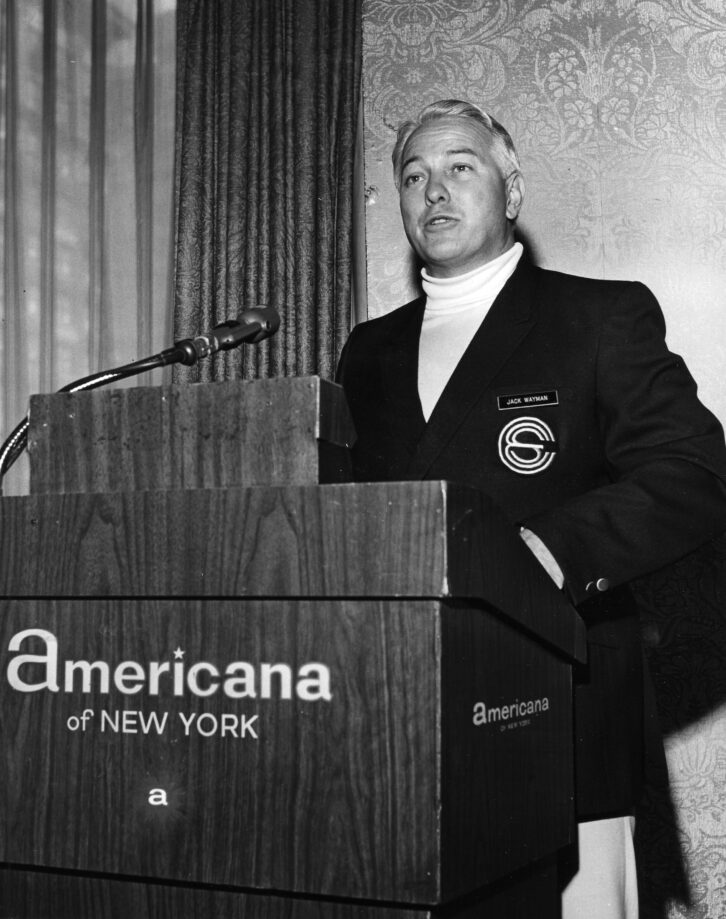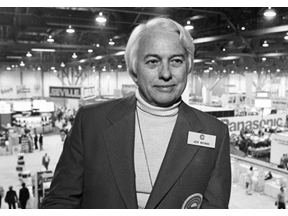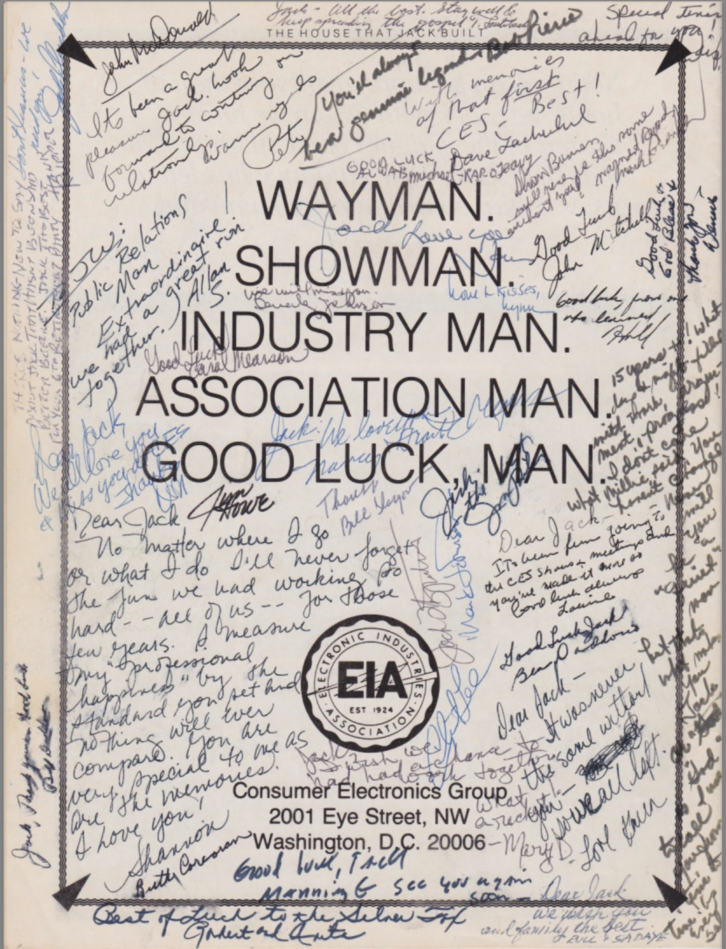A brief interlude examining the life of the consumer technology industry’s chief builder

This year marks the 100th anniversary of the founding of the CTA (Consumer Technology Association), which started out as the RMA (Radio Manufacturers Association). This is the fifth in a series of essays exploring and celebrating CTA’s and our industry’s first century of invention, innovation, and entrepreneurship, assembled from varying technology historical research and writings I have done over the course of 20-plus years, including from an annually updated industry history for CTA’s now-defunct Digital America, 20-plus years of CTA Hall of Fame inductee biographies, and numerous tech history articles for a variety of publications over the years.
Read Part 1: Founding here, Part 2: David Sarnoff here, Part 3: The TV Age here, and Part 4: The Sixties here.
We’re going to take a literary break here in our CTA centennial commemoration series, an interlude to catch our historical breath that mirrors the clean break between the first 50 years of our industry, comprised largely of only four products – TV, radio, phonographs, and cassette tape – to the second 50 years, which would see a technology explosion unlike any in human history.
In the last chapter, I talked briefly about the creation of CES and briefly mentioned the progenitor of that auspicious annual event, Jack Wayman.
Many of you either knew Jack or have heard his name. When Jack passed away at the age of 92 on August 30, 2014, there was what I considered a perfunctory New York Times obit two weeks after the fact, along with numerous personal remembrances of him here in TWICE and by CTA, and a touching memorial service held by CTA in New York a few months later.
See also: View TWICE’s video tribute to Jack Wayman here.

In short, over his 60-year industry career, Jack oversaw the evolution of the EIA Consumer Products Division – where he was named its first director in the fall of 1963 – from a $50,000 budget and no direct staff – into the Consumer Electronics Group (CEG) with a $15 million budget and 50 employees, and both founded and built CES into the world’s premier innovation showcase. Jack also helped score numerous victories on the legislative and public policy fronts, including the groundbreaking Sony-Betamax case that secured home recording rights for consumers and ignited today’s entire home video business.
After his “retirement” in the late 1980s, Jack remained a seminal and ubiquitous figure in both the industry and the public. He served as the industry’s media spokesperson, making more than 700 media appearances across the country over 20 years, as a judge for the CE Hall of Fame where I got to know him better, as a mentor to CTA staff and, thanks to his encyclopedic knowledge of people, places, and events, as an unofficial industry historian.
But for some reason, I never saw a full-fledged, fleshed-out industry-oriented biography of this singular and beloved consumer technology industry titan.
Unfortunately, the industry also seems to have no memory of RMA’s indispensable founding president, Herbert Frost, who I spent literally years researching but never quite caught a fulfilling enough glimpse of, a result partly of a dearth of records, and of industry and organizational neglect. It’s bad enough we have lost both Frost’s and Jack’s long, deep, and irreplaceable institutional memories and wisdom. I would at least like to make sure Jack doesn’t get lost in a similar industry historical fog.
This bio serves more of a purpose beyond simply remembering Jack, however. His first-person, lived-in, center-stage memories bring a far more colorful personal perspective to our industry’s evolution far more effectively than my otherwise dry, truncated, day-and-date, objective third-person bird’s-eye-view historical recitation. The lessons Jack learned and lived about how business is conducted in our industry are still applicable today.
I was lucky enough to get to know “the Silver Fox” toward the end of his life – lucky enough to be unlucky enough to be scarily driven by him in his huge and well-lived-in Cadillac with his attention devoted to everything and everywhere except the road – which is why I’m abandoning objective AP style here and will simply just call him Jack. He and I shared a passion for capturing our industry’s history for posterity, and he bequeathed to me a small duffle bag filled with his personal documents and manuscripts – which, after his passing (and my copying), I returned to his family.
Jack wrote a short autobiographical sketch in 2007 for the now-defunct Dealerscope to draw from. This autobiography is no longer available online (as far as I can tell), so I’ve used it as the backbone for this bio.
The personality and experiential similarities between Herbert Frost and Jack Wayman are fascinating but ultimately not surprising. Both exhibited valuable leadership skills gained through a combination of military experience and their natural bonhomie, the ever and natural ebullient, glad-handing, sharply dressed, back-slapping personality de rigueur in a salesman, all personality traits you have to be born before they can be honed by life.
Norman Jack Wayman was born May 12, 1922, in Miami, Florida, at a time when that state’s population had just topped 1 million people, and just as the industry he would one day lead was also being born. Jack was the only child of Dora and Jesse Wayman, a successful local builder, an appropriate legacy given how Jack would later build our industry. Jack worked with his father in varying menial capacities, but his father told his son “I want you to work – not with your hands. I want you to work with your mind.”
After a stint in a local grocery store, the precocious 10-year-old opened his own roadside stand selling mangoes, oranges, and pineapples to tourists, adopting his former employer’s universally applicable selling strategy: “Whatever fruit they want, tell everybody it’s sweet as sugar.”
Jack attended the Cushman Elementary School where was class president, then Miami Edison High School where he was captain of his basketball and baseball teams, president of his senior class, and a member of the National Honor Society, graduating when he was just 15. Turning down a West Point appointment, Jack went to Davidson College near Charlotte, North Carolina, to be a bigger fish in a smaller pond. He was successful; at Davidson, Jack was elected president of his fraternity, lettered in track and baseball, was again the captain of the school basketball team, and even served as head cheerleader, which makes perfect sense. While Davidson’s sports teams didn’t win much against the likes of Duke and North Carolina, Jack learned “how to handle hype and losers” as well as valuable leadership skills.
See also: CES 2024 Audience Audit Reveals Who Attended The Show
Jack also spent four years in Davidson’s ROTC program, rising to captain. After graduating in 1943, Jack entered the U.S. Army’s Infantry Officer Candidate School in what was then Ft. Benning, Georgia (now Fort Moore).
Rising from corporal to first lieutenant, Jack landed at Normandy in the days immediately after the June 6, 1944, D-Day invasion with a rifle company in the Army’s 30th Infantry Division. Like many veterans, Jack didn’t like to volunteer details of his wartime experience (at least with me). But he later told me that he served with distinction and honor (my characterization, not his) in the European theater, including the Battle of the Bulge and the liberation of a concentration camp, as part of one of the war’s most honored battle units. According to Wikipedia, the 30th Infantry Division’s WW2 exploits “involved 282 days of intense combat over a period from June 1944 through April 1945, [and] was regarded by a team of historians…as the American infantry division that had ‘performed the most efficient and consistent battle services’ in the European Theater of Operations (ETO).” You can read an in-depth report on the 30th Infantry’s service here.
Jack earned, among many honors, the Silver Star, the Bronze Star, the Purple Heart with Cluster (which means he was wounded multiple times), two Presidential Unit citations, five Battle Stars, and the Combat Infantry Badge. A year before he passed, Jack was inducted by France as a chevalier for his military service, and just prior to his passing, he was photographed smiling in bed, his wartime medals arrayed proudly across his chest. A true hero from the Greatest Generation.
A month after the war ended and his Army discharge and at career loose ends, Jack was hired by Arthur Vining Davis, chairman of Alcoa and the Alcoa fruit company, as his personal assistant for two years. More importantly, Davis encouraged Jack to move to Washington, D.C., and take the international track at Georgetown’s University School of Foreign Service, where he learned the art of compromise.
Now married with two children to support on just his G.I. Bill income, in 1947 Jack took a job at Lacy’s, a 12-store Washington/Virginia/Maryland radio-TV-appliance chain while still taking night classes at Georgetown. During his five years with Lacy’s, Jack rose from sales to sales manager during “the so-called ‘borax’ era of retailing product, with bait and switch advertising,” Jack wrote. “The bait, a TV set advertised for $99, would be nailed to the floor with a ‘sold’ tag on it before the store opened. Customers didn’t have the chance. You’d get fired if you sold the bait. Telegrams would be sent to customers who did buy the ‘bait’ (telling them) that the TV set fell off the truck on delivery and [to] come back to the store to make a new selection.”
From the colorful Runyonesque assortment of his Lacy’s sales staff compadres, many of whom moonlighted in various capacities at a local burlesque theater, Jack learned real-world people lessons. He soon could confidently “wait on a banker or the lowest grade government worker that came in that store,” Jack recalled. “You’re selling the sizzle, and you’re selling human nature. I learned to say ‘Sure’ to every question the customer had. ‘Can I have it delivered tomorrow? Is this warranty okay?’ Sure. Everything was ‘Sure.’”
See also: Kinsey Fabrizio Named President Of Consumer Technology Association
With his war experience and a new graduate degree in hand in 1952, Jack still dreamed of a career in diplomacy but yielded to economic reality. “I was 28 at the time and found out I would only be making about $6,500 a year in the foreign service. At the time, I was making much more just by writing up TV orders. It was a bonanza for salesmen in those days.”
Instead, Jack accepted an offer to become an RCA distributor with Southern Wholesalers. Jack covered six mid-Atlantic states, starting as a traveling salesman but soon moved up the ladder to better accounts back in Washington, D.C. More importantly, with his diplomatic training, Jack acted as RCA’s liaison on government affairs while also serving as the company’s advertising manager and trade show manager. Jack produced semi-annual RCA shows for some 100 retail accounts, as well as hi-fi and electronics shows.
“I really got into the trade show business by designing the RCA exhibits,” Jack recalled. “At lunchtime, thousands of government workers would come in. RCA artists would come down, Elvis and Vaughn Monroe would come in and sing for 15 minutes at high noon. We couldn’t sell (the public) anything, [we] had to send them to a dealer. But for a week or so, we’d show our products.”
In literary parlance, this is what’s known as foreshadowing.

After a decade of impressive achievements as an RCA distributor, Jack was offered a job at RCA’s HQ in Indianapolis. Having made a home in D.C., however, he declined. But the leadership of RCA, the 800-pound gorilla of the industry as noted in previous chapters, thought Jack would be perfect to become staff vice president of the home electronics division of the sprawling Electronics Industry Association.
As noted in Chapter 4, by the early 1960s, home electronics had ironically become the runt of EIA’s sprawling litter despite the segment being the founding rationale of the organization as the Radio Manufacturers Association forty years earlier. On September 1, 1963, when Jack joined EIA, the home electronics division consisted of only 12 member companies that conducted 90 percent of the industry’s business, and the section’s office, such as it was, had no real staff and consisted of just a desk and telephone in a basement room.
“I became a full trade association geisha,” Jack remembered. “You gotta dance and perform for them, and please everybody. It ain’t easy. People (on the home electronics division board) were archrivals and strong corporate entrepreneurs. To put them in a room and try to get a consensus? You need those diplomatic skills, I guess.”
Jack entered a transitioning consumer electronics world. While black & white television still dominated, sales of color TVs topped a million units a year for the first time in 1964 and would soon overwhelm the market by the early 1970s. Solid-state electronics, including new home stereo hi-fi gear, were just hitting the market, and Japanese manufacturers were making their presence felt. Distributors were on the wane, and retailers were getting larger. Within a year, Jack engineered an organizational name change from the home electronics division to the Consumer Products Division (CPD), and he more than doubled membership.
See also: CES 2024: Trends To Watch
Jack soon saw the need for a dedicated consumer electronics trade show, but it took three board meetings to convince his EIA overlords. “RCA and Zenith said ‘We’ll only support the show for one year,’” Jack remembered. “They did, and didn’t come back for a few years, using the show as they needed.”

The first CES venue choice was McCormick Place in Chicago, where the industry was born. But McCormick Place burned down “right in front of my eyes” in January 1967. Jack scuttled to New York City and quickly booked the Hilton and Americana, now Sheraton, hotels for the first Consumer Electronics Show that June. A bulk of attendees over the first four years of CES were members of the North American Retail Dealers Association (NARDA), which gave the show its base of attendance and, according to Jack, “made the show a success.”
You can read more details about that first CES here and here.
One of the industry fears at the time was the impact of new Japanese suppliers and potential international corporate espionage. On the first day of that first CES, EIA president and Motorola chair Robert Galvin “came in and said in that quiet voice of his, ‘Jaa-ack, I’m trying to demonstrate Quasar to a retailer, and these Japanese gentlemen keep pushing me aside to take photographs of the front of the television. Maybe we shouldn’t have cameras.’ So we decided ‘no cameras’ and spent that night painting signs and putting them up everywhere. The camera ban went on for several years or so, then we forgot about it for a couple of years.”
Then in 1971, after CES finally premiered in Chicago after McCormick Place was rebuilt, Panasonic head Ray Gates reminded Jack of the “no camera” rule. Apparently, RCA and Zenith photographers were pushing aside customers to take pictures of Panasonic products. “The Japanese had become the ones to copy!” Jack observed, the incident illustrating the unstoppable shift in the industry.
Jack slowly but surely started to build out the CPD in both staff and membership. In 1966, he hired J. Edward “Ed” Day, President John Kennedy’s former postmaster general who had implemented the Zip Code, as outside general counsel. He brought in country star Roy Clark and disco singer Donna Summer and created industry-hyping public service messages.
By 1970, CPD essentially operated independently of EIA with its own bank account, its own trade show, and its own staff. But then EIA hired its first paid president, who pushed the EIA board to bring all the divisions under more direct, top-down organizational and financial control. Jack fought to retain CPD’s independence, creating an on-paper independent Consumer Electronics Association, and actually pulled this nascent CEA out of EIA for a month.
But thanks to CES, CPD generated, according to Jack, 75% of EIA’s budget, and EIA was forced to relent and invite Jack’s errant group back in. But taking advantage of some reorganizational loopholes, Jack engineered a bureaucratic maneuver within EIA that transformed the Consumer Products Division into the more organizationally influential Consumer Electronics Group (CEG).
Jack also adopted what he called the three most important rules of business: One, “honesty – what you see is what you get.” Two, “a promise is a promise, and a handshake is a promise.” And three, “Don’t wallow in the past. It’s nice to talk about it, but you’ve got to look to the future. Shake it off if you’ve made some mistakes. Don’t look back.” And befitting the nature of the consumer electronics industry, Jack also adopted the then ubiquitous Panasonic advertising tagline: keeping “just slightly ahead of our time.”
See also: iRobot’s Angle, CTA’s Shapiro Lash Out At Regulation
Jack and CEG were also active on the policy and legislative front, establishing industry advertising guidelines including the adoption of TV diagonal screen size standards, and fighting for international adoption of U.S. TV standards. He also successfully supported the orderly evolution of “all channel” TVs that included both VHS and UHF frequencies, for a repeal of the 30-year-old radio-TV excise tax, for proposed Health, Education, and Welfare regulations concerning the control of excess X-radiation that emanated from some higher-power color TVs that prompted parents from then on to warn their kids to sit at least six feet away from the screen, and for anti-dumping regulations.
With the industry growing rapidly throughout the 1960s and early 1970s, Jack added a second CES, a winter show, in Chicago, first held January 12-16, 1973, at the Conrad Hilton Hotel. Reacting to growing complaints from exhibitors and attendees about dealing with the harsh winters in the Windy City, however, Jack moved the Winter CES to Las Vegas starting in January 1978 while maintaining the Chicago Summer CES.
Under Jack’s leadership, CEG also established its first standards and product safety committees and accepted membership of the American subsidiaries of foreign electronics makers. In 1978, the Institute of High Fidelity (IHF) mounted a rival trade show threatening CES, so Jack and CEG absorbed the IHF into CEG. As a result, “we became much more responsive to high-end audio,” Jack related. The following year, Jack established the CEG media spokesperson program, first with NBC newsman and Today Show host Frank Blair, followed by musician/conductor Peter Nero – and then Jack himself.
Jack’s and CEG’s most impressive regulatory victory took 10 years to win – the right for consumers to record broadcast TV shows at home on their new-fangled VCRs, resulting in the famous Supreme Court Sony decision on January 17, 1984 – which we’ll explore in more depth and context next week. Jack also chaired the Home Recording Rights Coalition and successfully fought the movie and recording industries’ attempt to tax blank tape and restrict rentals of pre-recorded cassettes.
Eventually, Jack grew CEG from a minor division into the second-largest EIA group.

In 1982, Jack made arguably his most important hire, current CTA chair Gary Shapiro. Gary (again, I’ll abandon AP style here since I’ve known Gary for nearly 40 years) worked for CEG General Counsel Ed Day’s firm and came with a glowing recommendation from his boss. Day told Jack that Gary would “save you money, and one day he’s going to take your place.” Jack graciously and proudly admitted that “Gary’s done a far better job than perhaps I ever did.”
At Winter CES 1988, Jack’s friends gathered to honor him on his 25th anniversary leading CEG. TWICE published a 36-page booklet entitled “The House that Jack Built” filled with tributes from companies and executives acknowledging Jack’s extensive contributions to building the consumer electronics industry. Jack kept a copy signed on every page by hundreds of well-wishers.

At around this time, Jack began to yield more authority to Gary, who would officially take over the CEG leadership reins in 1991 on the eve of CES’ 25th anniversary. Jack then started to hit the road as CEG’s media spokesperson. Over the next decade-plus, Jack would visit upwards of 50 markets a year encompassing hundreds of TV, radio, and newspaper appearances and interviews on behalf of the industry. Always armed with the latest gear, Jack soon became a familiar friendly figure on local TV, demonstrating the latest consumer electronics wonders to a ravenous tech-hungry buying public. He was joined on the road by Jim Barry in 1995 to cover more territory before Jim, a one-time editor of mine at Video Magazine, took over the spokesperson role full-time.
Jack received countless honors from the consumer electronics/technology industry. He was awarded the EIA’s Distinguished Service Medal and was inducted into the Convention Industries Council Hall of Fame, the Electronic Industries Hall of Fame, and the Video Hall of Fame. Named “Man of the Year” by several industry trade publications and organizations, Wayman also was chosen as “Man of the Decade” by Audio/Video magazine.

Even after his retirement from the road, Jack remained a familiar fatherly figure and advisor around CES and the industry, especially when CTA created its Hall of Fame in 2000. Jack was not only the most obvious pick of the first 50 industry inductees, but he served as the judging panel’s essential, encyclopedic, and irreplaceable institutional memory – especially to me – until he passed away on August 30, 2014.
In his honor, on November 10, 2014, CTA hosted a magnificently attended and tribute-filled memorial in New York, an appropriate send-off to our industry’s singular builder whose life and contributions I hope we all will continue to remember, appreciate, cherish, and learn from.
Next week, I’ll return to my more chronological recitation, covering the explosively inventive and societal disruptive period between 1975-1985 that saw the birth of the home video, home computing, video game, cellphone, GPS, Internet, and personal audio, and video, and digital audio and video revolutions – and the end of the RCA era.
See also: Jack Wayman Tribute Video